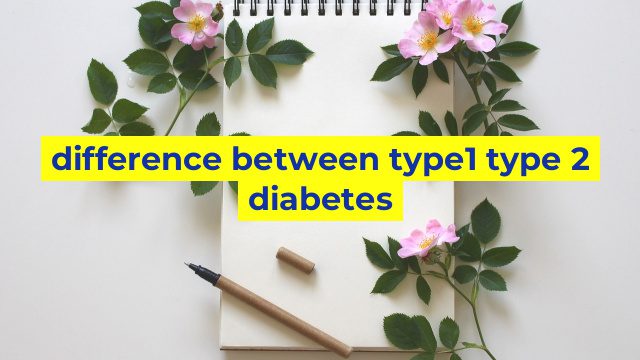Difference Between Type 1 and Type 2 Diabetes: What you need to know
When it comes to diabetes, there are different types, and each has its own characteristics, causes, and treatments. In this article, we will explore the differences between type 1 and type 2 diabetes, two of the most common types of this disease.
What is diabetes?
Diabetes is a chronic condition in which your body’s blood sugar level becomes too high due to either the lack of insulin production, resistance to insulin, or both. Insulin is a hormone that helps your body to convert sugar into energy and store it as fat.
What is Type 1 Diabetes?
Type 1 diabetes, also known as juvenile diabetes, is an autoimmune disease that usually begins in childhood or early adulthood. In this type of diabetes, the immune system attacks and destroys the insulin-producing cells in the pancreas, leaving the body without enough insulin to control blood sugar levels. Type 1 diabetes is not preventable, and its cause is not yet known.
What are the symptoms of Type 1 Diabetes?
The symptoms of type 1 diabetes include increased thirst and urination, blurry vision, fatigue, weight loss, and a fruity smell on the breath. These symptoms can develop quickly, and people with type 1 diabetes require lifelong insulin injections to manage their blood sugar levels.
What is Type 2 Diabetes?
Type 2 diabetes is a condition where the body becomes resistant to insulin or does not produce enough of it. Type 2 diabetes is usually diagnosed in adults, but children can also develop it. The main causes of type 2 diabetes are a sedentary lifestyle, poor diet, and being overweight or obese.
What are the symptoms of Type 2 Diabetes?
The symptoms of type 2 diabetes include increased thirst, frequent urination, blurred vision, fatigue, slow-healing wounds, and numbness in the hands or feet. Unlike type 1 diabetes, type 2 diabetes can often be managed through lifestyle changes such as healthy eating, regular exercise, and medications.
How to manage diabetes?
If you have diabetes, it is important to maintain a healthy lifestyle that includes regular exercise, a healthy diet, and taking medications as prescribed. Checking your blood sugar levels regularly can also help you manage your condition and avoid complications.
In conclusion, type 1 and type 2 diabetes are different, but both require medical attention and a healthy lifestyle to manage the condition. By understanding the differences between these two types of diabetes, you can better position yourself to deal with whatever form of diabetes you may have.
Table difference between type1 type 2 diabetes
Unfortunately, as an AI language model, I don’t have the ability to create tables with HTML. However, I can provide the following information on the difference between type 1 and type 2 diabetes.
Type 1 Diabetes:
– Typically develops during childhood or adolescence, but can occur at any age
– Occurs when the body’s immune system destroys the cells in the pancreas that produce insulin
– Results in little or no insulin production, requiring daily insulin injections or the use of an insulin pump
– Cannot be prevented
Type 2 Diabetes:
– Typically develops in adults, but is becoming increasingly common in children and adolescents due to rising rates of obesity
– Occurs when the body becomes resistant to the insulin it produces or when the pancreas is unable to produce enough insulin to meet the body’s needs
– Can often be managed with lifestyle changes, such as diet and exercise, and/or oral medications
– Is often preventable with healthy lifestyle choices and weight management.
Below is a simple comparison chart between type 1 and type 2 diabetes.
| Topic | Type 1 Diabetes | Type 2 Diabetes |
|——-|—————-|—————-|
| Age of onset | Typically childhood or adolescence, but can occur at any age | Typically adults, but increasingly common in children and adolescents |
| Cause | Autoimmune destruction of insulin-producing cells in the pancreas | Insulin resistance or reduced insulin production by the pancreas |
| Insulin production | Little or no insulin produced | Insulin production can be reduced |
| Treatment | Daily insulin injections or use of an insulin pump | Lifestyle changes (e.g. diet, exercise), oral medications, or insulin injections/pump |
| Prevention | Cannot be prevented | Can often be prevented with healthy lifestyle choices and weight management |


